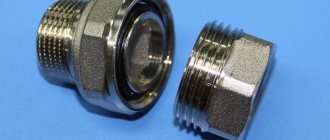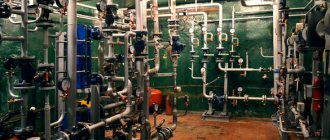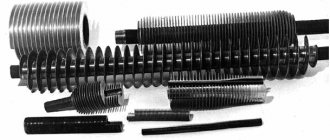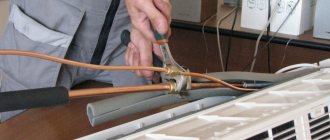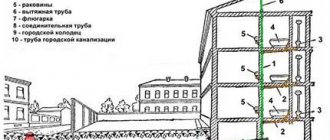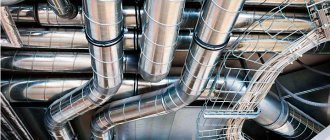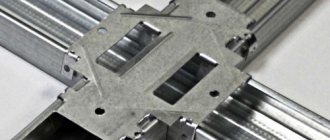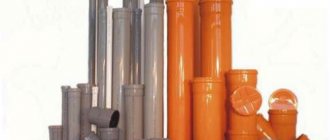Home / Heating /
For 9 years, at almost every project a builder always appears who, with a smart look, convinces the Customer to save on radiators and heat the house with heated floors. The customer has doubts and is right. At first glance, warm floors are more comfortable, but is it convenient for heating? Let's figure it out.
Good afternoon My name is Alexey Goltsov . I am a design engineer, author of articles. Heating is my main specialty. I carry out projects for country houses, shops and restaurants. 20 projects for country houses a year
I mainly design for Moscow and the region. I'm leaving for the site.
You can order a heating project from me on the “Services” .
Why did this question arise?
No matter how funny it may sound: global warming and the view of Western countries are to blame.
The design temperature for heating in Moscow is –25°C for 5 days. This temperature has not been seen for many years, and customers of private houses began to share the opinion that radiators do not work, and therefore are not needed.
Warm floors cost 3 times more than radiators. Therefore, this opinion was picked up by builders and for the last 5-7 years they have been confidently advocating to abandon radiators completely.
But there are 2 nuances in this issue that they do not take into account:
How many years are you building the house for?
My Customers often say that their neighbor’s underfloor heating works successfully. But neither the Customer nor the neighbor takes into account the period of time.
If we are talking about the short term of 3-5 years, then radiators are really not needed in this case. But the house is being built for a longer period.
In building codes, heating is considered efficient if it heats the house for 50 years. For Moscow, the minimum temperature for 30-50 years is -25°C. And even if there has not been such a temperature over the past 5 years, this does not mean that it will not happen in the coming decades.
Therefore, as a specialist, I design a combined system of radiators and heated floors. We are obliged to provide radiators as a reserve so that the house does not freeze in the cold winter.
We don't need to "heat the house"
Heating a house is an incorrect term.
The whole nuance is that we must maintain a different temperature in each room. We need to heat each room separately. In the boiler room, garage, storeroom, it is enough to maintain +15°C. In the bedroom +23°C, in the bathrooms and bathrooms +25°C.
Indeed, if we calculate the house as a single space, a warm floor for heating is quite enough, but in practice we only need to heat those rooms that border on external walls and windows.
For example, internal corridors, halls and storage rooms in a 250 m2 house are often about 50 m2, but they do not need to be heated at all.
Heating with diesel fuel
For heating with diesel fuel, you will also need a tank, and the costs of its installation will be comparable to the costs of autonomous gasification at home. At the same time, unlike propane-butane, diesel fuel cannot be called cheap.
High price. Diesel fuel is the most expensive source of energy used for autonomous heating of a private home. A kilowatt-hour of diesel fuel costs 4.75 rubles. Even electricity is a little cheaper. It may not be easy to spend more on heating.
Unpleasant smell. This is an inevitable property of diesel fuel. A strong smell will follow the unfortunate owner of a diesel fuel tank everywhere. The house will smell like a garage, and the area will smell like a running tractor, and nothing can be done about it.
Problems when using low-quality fuel. The use of low-quality diesel fuel can lead to serious damage to heating equipment. Those who use liquefied gas and DESIGN PRESTIGE gas tanks do not have such a problem: the quality of propane-butane does not affect its consumer properties.
Disadvantages of heating with diesel fuel
- High price.
- Sometimes you have to clear snow for winter delivery.
- Strong odor in the house and area.
- Use of storage space.
Is it possible to abandon radiators and heat the house only with heated floors?
From the legal side
Answer: No, you can't. If you contact a large construction company with such an idea, they will refuse you. There are 3 reasons for this:
1) The heating system is designed for the lowest temperature. For Moscow this is –25°C for 5 days. If the average temperature stays at -25°C for 5 days, no heated floors will cope. More details: SP60.13330.2016 clause 5.13.
Minimum winter temperatures in Moscow
2) The temperature of the floor surface should be no more than 26°C, and for children's institutions 23°C. This is too low a temperature to heat a room. Radiators heat up to 80°C. I will tell you further what overheating of the surface leads to. More details: SP60.13330.2016 clause 6.4.8
3) Cold convection currents always come from the window. Radiators cover 50% of the window width, which helps reduce the cold air flow from the window. More details: SP60.13330.2016 clause 6.4.4.
From a practical point of view
Answer: Yes, it is possible, but is it convenient? Unfortunately, neither customers nor builders see all the consequences. The customer relies on the experience of the builder. The builder relies on the experience of past projects. That’s why there are so many speculations and fantasies on the topic of heated floors.
I will share these consequences with you.
Warm water floor. Installation and main features
You still doubt your choice. Which is better, stop at radiators or start preparing the installation of heated floors. Just evaluate the amount of materials, equipment and level of work required in each individual case. This will give you immediate answers to many questions, whether to leave the heating radiators or opt for heated floors.
First you need to understand what the main stages of installing heated floors are. Why start with this heating option? The thing is that this method is considered newer and little-studied for most consumers.
It is better to install warm water floors in a new building, when finishing work has not yet begun, and instead of a floor there are simple concrete floors. We take into account the fact that with water circuits laid in the floor, the ceiling height in heated rooms will decrease by 100-150 mm. For a private house this does not pose a problem, but for a city apartment it sometimes becomes critical.
The basic installation is as follows. The surface is prepared on which a layer of thermal and waterproofing is laid. Next comes a mesh or special mats on which the water pipes of the heating circuit are laid. As a result, your floor takes on the appearance of a layer cake. This design is called a layer cake, in which each layer plays its own specific role.
Before concrete wet work, a damper tape is glued around the perimeter of the room, which plays the role of a compensator for the thermal expansion of the concrete surface. The water pipe is laid according to two patterns, a snake or a spiral. Depending on the heating intensity, you choose the laying scheme yourself.
Only after connecting the water circuits to the distribution equipment (pumping and mixing unit) is a test run carried out. If no flaws are found in the technical part of the system, there are no leaks and heating is in accordance with the specified parameters, you can begin laying the concrete screed.
Underfloor heating without radiators is usually chosen when there is a powerful autonomous high-power heating boiler. In a house where constant heating is required, there is a constant consumption of hot water, heated floors must work without interruption. It is thanks to a powerful boiler that the required heating intensity of the coolant and the flow rate satisfying the technological parameters are achieved.
What problems do you have to face when heating underfloor heating?
The house will not warm up before your arrival
Warm floors without radiators respond very slowly to any commands and changes. His inertia is too high.
First, the system will receive a command from the boiler, then it will warm up 45 mm of concrete screed, 20 mm of floor covering, and only then it will begin to slowly release heat into the room. The floor temperature is 35°C. Therefore, to heat the house from the standby temperature of 15°C to a comfortable 23°C, the heated floor will need approximately 11 hours.
Heated floor heating rate graph
If you do not plan to live in the house 24/7, underfloor heating will be uneconomical. When you are not at home, you will have to maintain not 15°C, but 20°C, otherwise the house simply will not have time to warm up before your arrival. Radiators will heat a house from 15°C to 23°C in an average of 3 hours.
No reserve in case of extreme cold
In a combined system, radiators turn on at an outside temperature of -12°C and work together with the heated floor.
Warm floors are needed for comfort. That is why it is “warm” and not “hot”. Heating a house with underfloor heating will not work in extreme cold.
If you decide not to install radiators, you are deprived of a reserve that is guaranteed to heat the house in extreme cold. In this case, you will have to overheat the floors and run across the floor. Overheated surfaces will emit odor.
According to calculations: an overheated floor can heat a room down to -16°C. At lower temperatures, the floors will not cope and the room will be cold.
Floor covering - tiles or porcelain stoneware
Underfloor heating imposes its own limitations on the coating material. Even small carpets on the floor will have to be eliminated throughout the house, because they completely block the heat flow.
Heat transfer from the floor surface directly depends on the coating material. You won't be able to afford parquet, laminate, PVC or cork. all this is not suitable for underfloor heating systems. Laminate and parquet transfer heat 7 times worse than tiles.
Important nuance : the internal composition of the material is not so important as the surface itself! Matte and ribbed surfaces of the same porcelain stoneware transfer heat 30% worse than smooth ones.
No floor-to-ceiling stained glass windows
Stained glass windows in rooms create large heat losses. About 50% larger than ordinary windows, so heated floors are not suitable for heating a house with stained glass windows. You will have to give up façade and stained glass windows in all living rooms.
It is permissible to heat underfloor heating in rooms with 1 or 2 regular windows. If the windows are stained glass, the warm floor will not cope.
A warm floor in a room with stained glass windows can heat the room at an outside temperature of at least -12°C, which is why in Europe warm floors are used as the main heating system. This is unacceptable in Russia.
Local hot spots or furniture with legs
With underfloor heating, the only source of heat is the floor surface. In bedrooms, furniture usually consumes 40% of the space. Sofas, wardrobes and beds completely block the heat flow from the floor to the air, so heat exchange does not occur and the room is not heated.
Therefore, there are 2 options for solving this problem: – sofas, wardrobes and beds must have legs; – local overheating zones along the windows.
Local overheating zones are the area of the floor around walls and windows in which underfloor heating pipes are laid close to each other, with a reduced laying pitch, which results in an increase in heat flow.
Usually in bedrooms, the local overheating zone exactly falls on the area around the bed, so when you wake up on a frosty winter morning and get out of bed, you will definitely hit the hot zone of the heated floor with a temperature of 38-42 ° C, while without radiators the air temperature in the room will be about 18 ° C .
Radiators everything is clear and simple
With radiators everything looks much simpler. Having an autonomous heating boiler or a central heating system, we ourselves determine how the pipeline will be installed and the heating devices connected. Two types of heating systems are usually used, open type and closed type. In the first case, you will need to lay one main line into which all the batteries in the house will be connected in series.
With an open heating system, you will have to lay two pipes, a supply line and a return line. In this case, the batteries are connected in parallel. This connection diagram is very convenient. You can always turn off one of the radiators, thereby reducing the load on the boiler and lowering the room temperature.
Of all the things you'll need to equip this heating option, the most expensive component is the radiators. These devices, cast iron or steel, are quite expensive. However, it is difficult to compare other materials with them in terms of operation, efficiency and durability. Bimetallic or aluminum radiators are cheaper, but are inferior to cast iron batteries in efficiency and reliability.
New models are installed in new buildings, where in most cases there are autonomous gas boilers.
When can you heat a house without radiators?
For this article, I analyzed the heating calculations of 20 cottages. For Moscow, the heating system is calculated according to standards for –25°C, St. Petersburg –24°C, Kazan –31°C, and only in the Krasnodar and Stavropol Territories, Rostov-on-Don and Crimea can it be heated with heated floors without radiators.
You can heat your house with underfloor heating when the outside temperature is not lower than -18°C.
Special construction region. Krasnodar region, Stavropol region, Rostov-on-Don and Crimea.
You do not plan to live in the house in winter. In the fall, you drain the water supply system and heated floors and close the house until spring.
Additional heat sources. Do you have a fireplace, stove or electric heaters?
Building with temporary use. Garage, covered gazebo, separate bathhouse. There is no point in maintaining a temperature of +23°C. In the most extreme cold, you will not be in the building, and the standby temperature of +15°C is sufficient. Warm floors will do.
Heat pump. Heating with heated floors is recommended by sellers of heat pumps. The heat pump does not prepare water at 80 °C - as needed for heating, but only 55 °C, which is optimal for a heated floor system. Radiators on water at 55°C will turn out to be huge.
How does a water heated floor work?
Ordinary water is used as a coolant, which circulates inside the system under pressure. For this reason, it is extremely important to use a pump. Water can be supplied from central heating or from a riser.
The use of water heated floor heating in an apartment is prohibited by law.
The coolant can circulate without a system, but installing such a heating system will be extremely difficult, because you will have to comply with special gravity rules. In addition, the effectiveness of such a warm floor will only be proven if the building is high-rise and has a small area.
The advantages of water heated floors include the following:
- budget option in terms of installation;
- low cost of water compared to other energy sources.
Disadvantages:
- risk of damaging pipes;
- the coolant will not be able to function without a pump if the pressure in the system decreases;
- It is impossible to install such a floor in an ordinary apartment, because the water from the central system, after passing through the heated floor system, turns out to be cooled, which causes inconvenience to other residents of the house. To this day, it is prohibited to use heated floors from centralized heating in an apartment.
How much underfloor heating is needed for heating?
The issue of heating a house only with warm floors needs to be worked out at the stage of the architectural project. Rooms with stained glass windows cannot be heated with underfloor heating alone; radiators are required. But rooms with conventional glazing are quite suitable for underfloor heating.
To heat rooms only with heated floors, you need to deliberately increase the free area of such rooms.
We know that 40% of the area is occupied by furniture, so we need to compensate for the missing space by combining rooms with adjacent rooms: combining a bedroom with a dressing room, moving the door to the corridor.
The formula for any type of house looks like this:
Spom – room area in m2 For a room with 1 window and a window sill Spom x 0.69 (69% of the floor) For a room with 2 windows on different facades Spom x 0.79 (79% of the floor)
For example , for a bedroom of 21 m2 with 2 windows, the required heated floor area is 21 × 0.79 = 16.6 m2. Furniture occupies 40% of the area, which is 0.4 x 21 = 8.4 m2. To heat such a bedroom with a warm floor, we need to increase the floor area by 16.6 - (21-8.4) = 4 m2. As a result, we need to expand the room by 1 m2 and add a dressing room of 3 m2.
Using this formula, you must first calculate the total area of all bedrooms, and only then adjust the area of the remaining rooms.
Which is better: heated floors or radiators?
For heating in autumn and spring - warm floor. In winter - radiators. Warm floors are a low-temperature system and respond slowly to weather changes.
In spring and autumn, the temperature difference between inside and outside the house is not as significant as in winter. Therefore, warm floors during this period, despite their slowness, are much better than radiators.
But in winter the picture is the opposite. In the house +23°C, outside -15°C. The temperature difference is huge. The cold flow from windows and stained glass penetrates into the room much more intensely than in autumn or spring. We need to stop these flows. Nothing can be better than radiators or convectors built into the floor.
Combined heating - floor + radiators
It is possible to combine two types of heating in a private house when:
- radiators act as the main source of heat, and heated floors act as an additional source;
- heated floors are the main heating system, and radiators are auxiliary.
If you have a two-story cottage, to heat it, the ideal option would be to install heated floors on the first floor, and heat the second floor using a radiator.
This combination allows you to fully use the positive aspects of both systems and heat your home more economically.
Analysis of misconceptions
Uniform heating with heated floors. The temperature in the legs is higher, above the head – lower, and this is good, because... evenly and physiologically. Complete nonsense! Our task is to ensure not uniform, but rather local heating of the room in the areas of windows, external walls, corners, and street doors. We need to stop the cold currents from these surfaces.
Cost-effectiveness of heated floors?! How can a system that responds slowly to change be economical? The room became hot - and the warm floor will reduce power only after a couple of hours. Where are the savings?
Warm floors for allergy sufferers are complete nonsense! The phenomenon of “dry sublimation of dust” begins at temperatures above 90°C. The smell of dust from radiators comes only because they generally forget to wash them. In this case it has nothing to do with temperature.
Warm floors retain moisture. In winter, the air outside is dry by itself: 0.39 g/kg. In summer – wet – 10g/kg. Air humidity does not depend on the temperature of heated floors or radiators.
If there are misconceptions that I missed, write to me, we’ll discuss them and add them to the article.
Types of batteries
Radiators are made from different materials. They are:
- cast iron;
- steel;
- aluminum.
Each metal has its own pros and cons that must be taken into account when replacing.
Cast iron
They have a working pressure of 9 bar. As for other characteristics, they are:
- height – 350-1500 mm;
- depth – 50-140 mm.
Such batteries, although they began to be used a long time ago, are still very popular. Their main advantages:
- relatively low price;
- ability to add sections;
- durability;
- ability to use with any coolant;
- high efficiency.
If we talk about the disadvantages that must be taken into account when comparing whether a warm floor or cast iron radiators are better, then they are also very significant:
- The room takes a long time to heat up after the radiators are turned on.
- The heat output of cast iron batteries is 110 W per section, which is quite low.
- You need a lot of coolant.
- These batteries weigh a lot.
- As a rule, the design does not differ in variety.
Aluminum and bimetallic
They appeared later than cast iron, but quickly gained popularity. Users appreciate:
- high heat transfer;
- ease of installation
- efficiency;
- little weight.
In bimetallic batteries, most of these disadvantages are eliminated.
Steel
There are two types of such batteries:
- panel;
- tubular.
Operating pressure can range from 5 to 16 bar. Steel radiators provide temperatures up to 120°C. Their dimensions may be as follows:
- height – 200-900 mm;
- depth – up to 225 mm.
Steel batteries are much more durable compared to others. They have other advantages:
- high heat transfer;
- reliability;
- strength;
- low cost;
- simple installation;
- different connection options.
Advantages of radiators
1. Installed under the windows . Windows are a source of rapid heat loss. The temperature outside changes all the time, which leads either to an increase in the cold flow from the window or to its decrease. The radiator smoothes out these flows.
2. No requirements for premises. Over the years, you can replace tiles with parquet, lay carpets, install monolithic furniture and not depend on the requirements for heated floors.
3. No overheating areas that are uncomfortable to walk on.
4. No odors from furniture or carpets. Warm floors heat up the furniture. There is a smell coming from the furniture.
Radiators
The advantage of the classical method is the low cost of installation compared to heated floors. And the main disadvantage is the uneven distribution of heat. Much depends on the type of radiator and how it is connected. The coolant of the effective battery is about 70 degrees. It is the high temperature that allows the radiator to have compact dimensions. The lower the coolant temperature, the more radiators are required to heat one room. What other advantages and disadvantages do the classics have:
the radiator and heating pipes are always visible, which affects the interior design;
- The performance of the radiator is easily regulated by a thermostatic head, the temperature change will occur within an hour, while in a heated floor system you will have to wait several hours;
- Due to the fact that the entire system is visible, it is easy to repair and replace some elements with more efficient ones. The warm floor is installed into the concrete screed once and for all;
- finned radiators give off heat by convection by 80%, the rest by radiation;
Ribbed radiators in the interior
- convectors transfer heat by convection, which leads to increased dust circulation in the room;
- Aluminum radiators emit only 8% of heat, the rest is convection;
- panel radiators radiate 35%, the remaining percentage is convection.
Conclusion
Each house is too individual to promise anything without calculations. It is possible to heat a house with underfloor heating, but this issue needs to be discussed at the stage of the architectural project.
Combine bedrooms with a dressing room, increase the area of the rooms due to corridors and moving doors. Conceptually, you need to think through each room separately.
A house without a project is just “savings”.
If you find a company that easily answers this question, I advise you to doubt the competence of these people. The issue is complex and requires a thoughtful approach.
If you don’t have time to experiment with the heating system, or don’t have extra money for constant improvements, I recommend calculating the heat loss of the building, or better yet, designing a heating system and heated floors.
You can order a project from me in the “Services” . Based on calculations, we will be able to select the right radiators, pipes and find out the exact cost of equipment and installation work. We will be able to understand which rooms can be heated with underfloor heating and what architectural modifications are needed for this.
Preliminary project cost calculator
Thanks for reading! For the design of engineering systems, please call or email [email protected]
You might be interested in:
How to choose a design company? Guide for the Customer What is included in the design cost? 10 reasons to work with us
Comments
- Leonid:
06/01/2020 at 17:23In practice, 3 houses are fully heated with underfloor heating, everyone is happy. You have too many pros and cons.
Answer
- Goltsov Alexey:
02.06.2020 at 15:57
Leonid, Good afternoon. Thank you for your attention. An excellent phrase: “In practice, 3 houses are completely heated with underfloor heating.”
1) What do you mean heated? At what temperature? At -10°C - is it “heated”? and at -25°C? Professionals don't talk like that. According to the standards, “houses are heated” at -25°C for 5 days for Moscow. This temperature has not been seen for a long time. I suspect that you are misleading me.
2) What does completely mean? — My sofa is near the window, the guests are sitting with their backs to the window. In the morning they complain - “the back is blown.” Is it complete or not complete? or is the guest to blame? or is the owner a fool? And the Code of Rules SP 60.13330.2016 - are we violating because we come up with our own rules? Is that how it works?
3) The house will be warmed up with warm floors from 12 degrees to 23 for 11 hours. This is a minus that outweighs all the pluses.
Answer
- Alexander:
01/18/2021 at 10:06
I will be very surprised if my post gets approval)) But the author must be able to admit his mistakes.
Answer
- Goltsov Alexey:
01/18/2021 at 14:38
Alexander, Good afternoon. There is no need to treat people as idiots. I really won't post your messages with an advertising link.
You are involved in heat pumps. Radiators don't work with a heat pump, so you're left with underfloor heating. Your income and the well-being of you and your family depend on it.
For my readers: - Alexander wrote that heated floors are 20-30% cheaper than radiators. — Local overheating zones are not dangerous. I didn’t specify what exactly is not scary. — Stained glass windows and heated floors are combined within reasonable limits. He did not specify where reasonable limits begin and end. — Sent the video to my resource
Answer
- Ulvi:
04/25/2021 at 21:00
I don’t even know what to say, but I was working in such an office, sitting all day in a huge room of 150 square meters, even more, and there was only a warm floor. It was very hot, even stuffy in winter. But in our street the maximum temperature is -2
Answer
- Goltsov Alexey:
04/26/2021 at 13:23
Ulvi, the floor area of an office space is much larger than the area of the external walls and windows; if you have a single room of 150 m2, then underfloor heating is possible. My article about underfloor heating for private homes.
Answer
We install a water floor
In a private house, no one will forbid you to install a hydraulic heated floor. But it needs to be installed efficiently, because comfort, safety, the durability of the system itself, and savings depend on this.
Preparing the premises
Any important business must begin with preparation, in this case the premises:
- Mark the level of the top layer of your floor.
- Drill holes for the pipes.
- Make technological niches.
- Prepare the subfloor - it must be leveled so that the misalignment does not exceed 5°.
Thermal insulation
After the room is ready, it is necessary to lay thermal insulation.
Foam plastic, polyurethane and other similar materials are suitable for this. The best option is a vapor barrier - for example, made of polystyrene.
The vapor barrier needs to be fixed and glued, for which a damper tape made of foamed polyethylene is used. It is attached around the perimeter and at the joints slightly above the screed. Then the heat insulator is laid - the mounting plate.
Pipe laying
A variety of pipes are used for heated floors:
- copper;
- steel;
- polyvinyl chloride;
- made of metal-plastic;
- high strength polyethylene.
When laying pipes, you must follow some rules:
- It is necessary to retreat 15 cm from the external wall.
- Pipes must not be laid at the joints of floor panels.
- In the middle of the room, installation with large steps is possible.
As for the types of installation, there are several of them:
- snake;
- double snake;
- snail.
In addition to preparation and installation, installation includes the following steps:
- connection to the distribution manifold;
- crimping;
- pouring concrete;
- installation of an expansion joint.
The first option is for copper or polyethylene pipes, the second is for steel and metal-plastic. Pressure testing is carried out before pouring concrete, since at this stage the quality of the entire system is checked.
No fill
Not so long ago, the so-called no-fill hydraulic floor appeared. It is not yet very popular, and its efficiency is lower, but it can be used in apartment buildings. Installing it is much easier and faster:
- Thermal insulation is laid on the ceiling.
- A layer of chipboard or polystyrene boards is laid on top.
- The main layer and heat distributing plates are laid.
- The plates are covered with a vibration-insulating layer.
- The whole thing is covered with an outer layer, usually a laminate.
